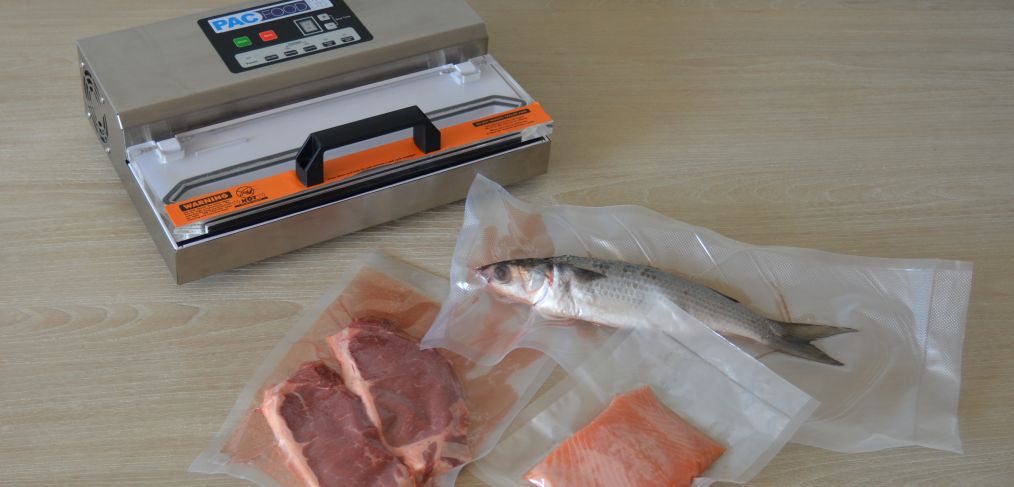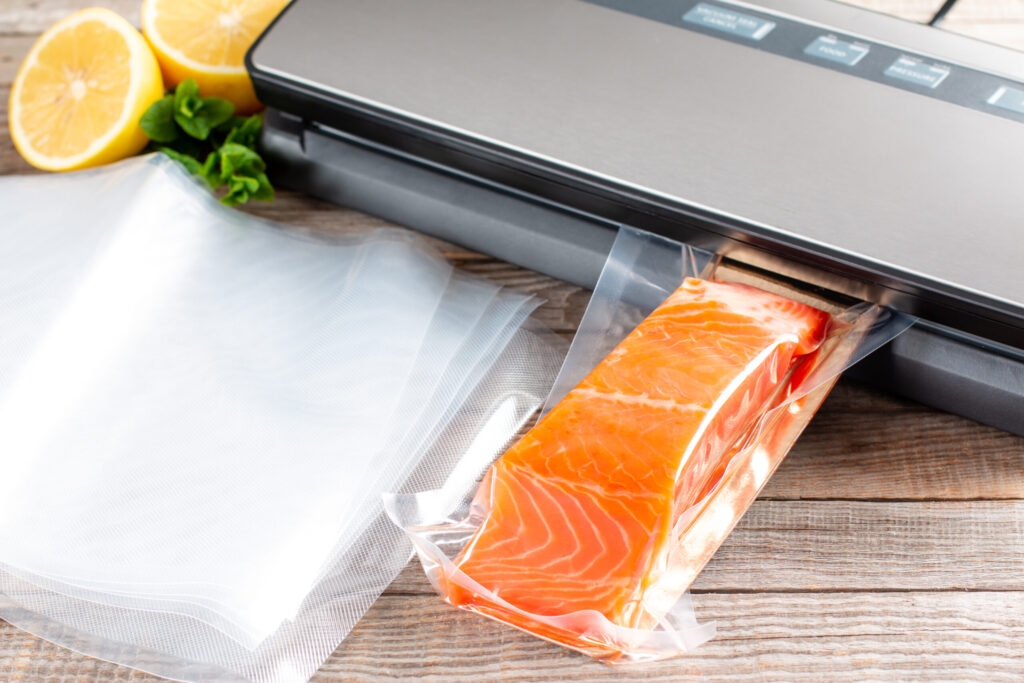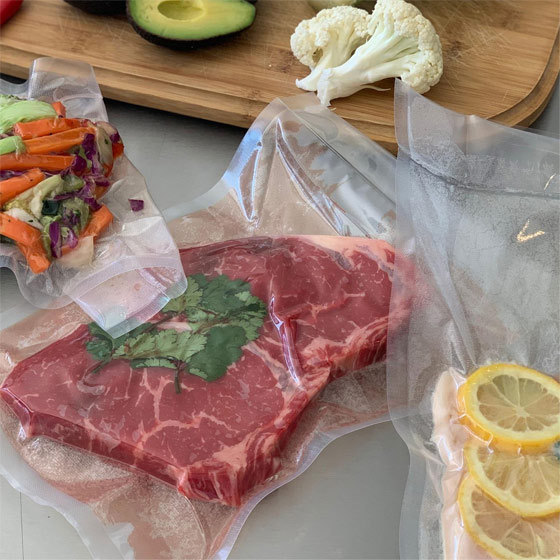For home cooks and professionals alike, vacuum sealing has become the favoured approach to extending the shelf life of food, cutting food waste and keeping food fresher for longer. Vacuum sealing helps preserve flavour and nutrients by limiting exposure to air, protects food from freezer burn, and helps marinades penetrate better. That’s why it’s particularly popular for moist foods.
But vacuum sealing liquids can be a bit trickier than dry goods. Moisture can cause the seal to fail, damage your vacuum sealer and create the ideal conditions for bacteria to grow.
Here, we teach you the right way to seal moist foods so that whether it’s leftovers or cut fruit, you can save money, cut waste and safely store your food for longer.
The Challenges of Vacuum Sealing Moist Foods
Whether you’re sealing food for sous vide cooking or to create more storage space in the refrigerator, liquids and runny foods can cause these common mishaps and challenges.

- Using the wrong vacuum bags. Ripped and leaky bags are normally of inferior quality. Ensure you buy the right type of vacuum bag for the job.
- Not selecting the right setting. Select the ‘wet’ or ‘moist’ mode on your vacuum sealer if there is one.
- Forgetting to dry the seal. Liquids can interfere with the sealing process. Always ensure the seal area is clean before you start.
- Accidental damage. If your vacuum sealer sucks liquids into the machine, stop vacuuming as it may cause damage.
- Poor food safety. Incorrect sealing can lead to food poisoning as bacteria can spread rapidly in liquid food.
- Overfilling vacuum bags. Don’t fill the vacuum seal bag all of the way to the top, as you risk sucking up liquids.
Essential Equipment and Supplies
The best vacuum sealer for liquids is a chamber machine. However, these are most commonly used in commercial settings.
If you’re using an external or out-of-chamber vacuum sealer, you’ll need to take a few precautions (see below) before beginning to seal moist foods.
Always use high-quality, food-grade vacuum sealing bags from a trusted supplier such as Pac Food. Our super-tough embossed micro-channel bags (or rolls) are designed to be compatible with most vacuum sealer brands.
Step-by-Step Guide to Vacuum Sealing Moist Foods
While vacuum chamber sealers are best for sealing moist foods and liquids, you can use out-of-chamber or external vacuum sealers if you take some precautions.
Liquid foods like stews and soups should be pre-frozen so that vacuum bags seal properly. Put into small containers or large ice cube trays in the freezer for several hours until completely frozen. This is best for goods that will be stored in the freezer. You can also try pre-sealing food in a non-vacuum bag before you vacuum pack it.
For juicy fruits, you can insert paper towels into vacuum bags before sealing to suck liquid up from around the fruits and prevent the juice from ruining the seal.
Food Safety Considerations
To make your moist food safer when preserving with vacuum sealing, you should always ensure it is completely cool before removing all the air from the bag. Warm or hot food promotes bacterial growth, and heat within a sealed bag can cause steam to form. This condensation puts the contents of the entire vacuum bag at risk. It can cause the seal to fail, meaning oxygen can enter and bacteria can grow. It also means leaky bags!
When refrigerated, foods with a high moisture content don’t last as long as drier foods. However, vacuum sealing can still prolong their lifespan by 3-5 times. For example, fresh meats that would normally last 2-3 days in the fridge when packaged in plastic wrapping can last up to 10 days when vacuum sealed. However, you should always use common sense when it comes to food safety and remember that vacuum sealing doesn’t prevent spoiling.
When thawing vacuum-sealed frozen meats or fish, always remove the food from the vacuum bag before thawing in the refrigerator or cook immediately from frozen. This exposes the food to oxygen and significantly reduces the risk of botulism, which thrives in anaerobic (oxygen-free) conditions.
Best Foods to Vacuum Seal When Moist

From vegetable soup to freshly caught fish, moist foods can be safely sealed without mess if you take a few precautions. It’s best to use a vacuum chamber sealer that’s suitable for liquids or take the precautions above for an effective seal of these moist food products:
- Stews, sauces and condiments
- Fresh fruit with natural juices
- Cooked vegetables and grains
- Dairy goods like hard cheeses and butter (avoid vacuum sealing soft cheeses, yogurt, or custard due to higher bacterial risk)
- Meat and fish
- Meat with marinades
Tips & Tricks for Better Results
- Make thawing easy by sealing small portions instead of one large single bag.
- Always label bags clearly with their contents and freeze date.
- Always defrost frozen foods safely in the refrigerator.
- Choose thicker, higher-quality vacuum bags to prevent leaks.
- If you vacuum pack liquids or moist foods regularly, consider upgrading to a chamber vacuum sealer.
We Help You Pac Foods So That They Last Longer

It’s not hard to vacuum-seal liquids, moist or runny foods, if you take the right steps before you start the process. Investing in a high-quality vacuum sealer and using the right bags can also make all the difference to the freshness of your food and the ease with which you can store it.
At Pac Food, we stock affordable and reliable vacuum sealers and super-strong, BPA-free vacuum pack bags and rolls. Visit our website to see our full range or read more about the dos and don’ts of vacuum sealing.
FAQs
What is the best way to vacuum-seal wet food?
The best way to vacuum-seal wet food is to freeze it first or pack it in a separate bag before sealing.
Can wet food be vacuum sealed?
It’s best to use a chamber vacuum sealer to seal wet food, but you can use an out-of-chamber sealer if you freeze liquids first.
How do you prevent botulism when vacuum sealing?
To prevent botulism when vacuum sealing, always store perishable foods in the freezer for long-term safety, or in a refrigerator at 3°C or lower for a maximum of 10 days. Critically, always remove frozen, vacuum-sealed fish or meat from the bag before thawing to expose it to oxygen, which inhibits the growth of the toxin-producing bacteria.
How to vacuum wet food?
Vacuum-seal wet food by freezing it first or by putting it in a non-sealed bag before you place it in your vacuum sealer. Hit the seal button to remove the air and then store it in the refrigerator or freezer.

